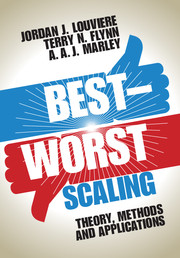Book contents
- Frontmatter
- Contents
- List of figures
- List of tables
- List of contributors to application chapters
- Preface
- Acknowledgments
- Theory and Methods
- 1 Introduction and overview of the book
- 2 The BWS object case
- 3 The BWS profile case
- 4 The BWS multi-profile case
- 5 Basic models
- 6 Looking forward
- Applications: Case 1
- Applications: Case 2
- Applications: Case 3
- References
- Subject index
- Author index
3 - The BWS profile case
from Theory and Methods
Published online by Cambridge University Press: 05 October 2015
- Frontmatter
- Contents
- List of figures
- List of tables
- List of contributors to application chapters
- Preface
- Acknowledgments
- Theory and Methods
- 1 Introduction and overview of the book
- 2 The BWS object case
- 3 The BWS profile case
- 4 The BWS multi-profile case
- 5 Basic models
- 6 Looking forward
- Applications: Case 1
- Applications: Case 2
- Applications: Case 3
- References
- Subject index
- Author index
Summary
You are at your very best when things are worst.
Starman (Jeff Bridges), describing the human race to an Earth scientist, in Starman (1984: Raynold Gideon, screenwriter; John Carpenter, director)3.1 Introduction
This chapter describes, discusses and illustrates the BWS profile case (Case 2). Researchers familiar with discrete choice experiments will recognize that this case has many features in common with DCEs. For example, like traditional DCEs, a good or service is described by a common set of attributes and levels; the descriptions are called profiles (hence, the name for this case). As in traditional ratings-based conjoint analysis (Green and Rao, 1971; Louviere, 1988a; 1994), the profiles are presented to experimental participants one at a time. In this sense, this case is somewhat like binary response DCEs that present profiles one at a time and ask for “Yes”/“No” (accept/reject, etc.) responses.
However, this case differs from traditional conjoint analysis and DCEs because experimental participants choose, respectively, the best and worst attribute levels in each profile. In other words, participants do not make holistic profile choices. Our experience is that this is an easier task for participants, as they evaluate only one profile at a time instead of choosing among two or more profiles, as in most DCEs. The one-profile-at-a-time aspect may be attractive in applications in which DCEs rarely have been used, such as the United Kingdom's National Health Service. Indeed, the authors have a fair amount of experience applying Case 2 to health-related research problems.
In the past researchers wanting to analyze data from Case 2 had to write special-purpose estimation software or develop a “work-around” in statistical software products such as SPSS, STATA and SAS. We suspect that the latter problem and the fact that formal proofs of the measurement properties appeared only recently (Marley, Flynn and Louviere, 2008) are responsible for less exposure for Case 2 than Case 1 or Case 3. Accordingly, we discuss these and other issues in this chapter to give this case more exposure; indeed, as we later discuss, Case 2 has unique advantages not shared by other conjoint, DCE or utility theoretic approaches for preference elicitation.
The plan of the rest of the chapter is as follows. We first describe and illustrate BWS profile case choice tasks (hereafter, “Case 2”). We then discuss issues associated with designing and implementing profile case projects.
- Type
- Chapter
- Information
- Best-Worst ScalingTheory, Methods and Applications, pp. 56 - 88Publisher: Cambridge University PressPrint publication year: 2015

